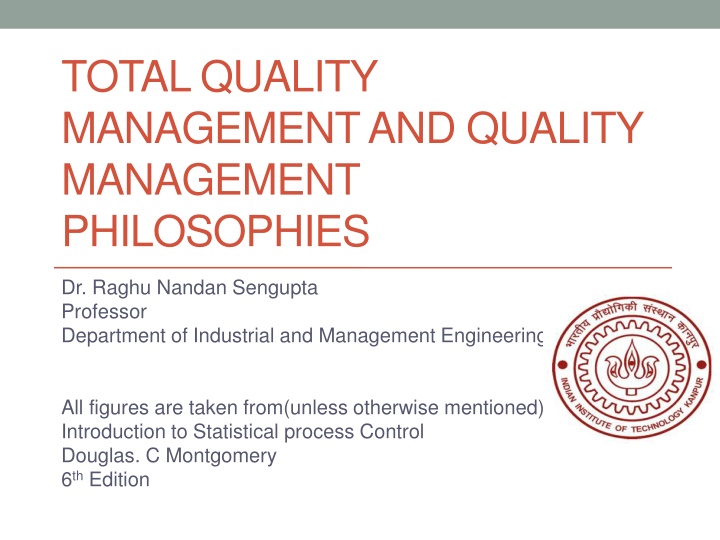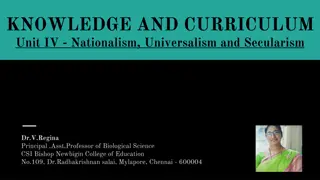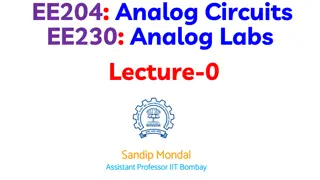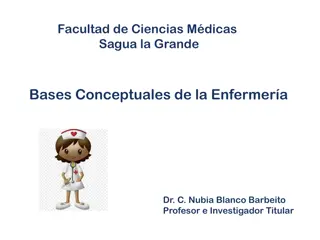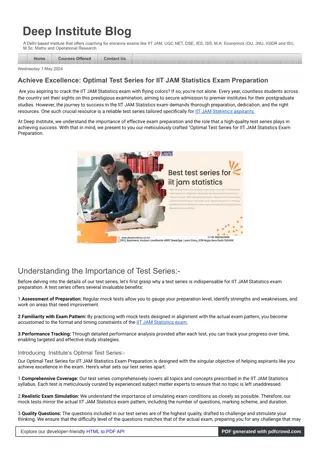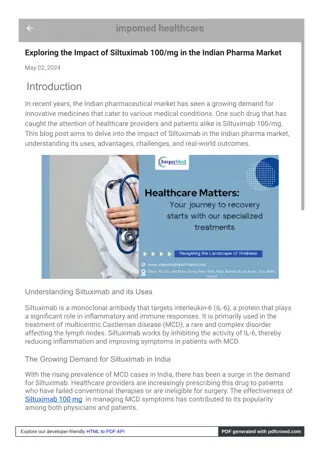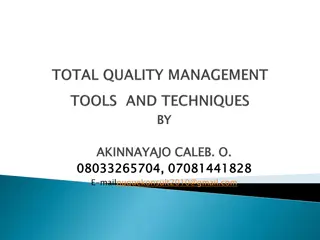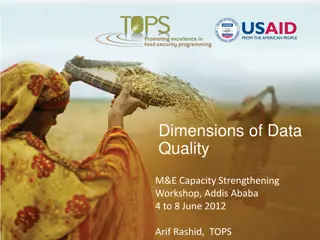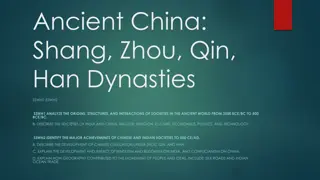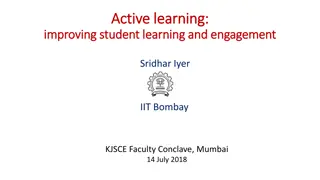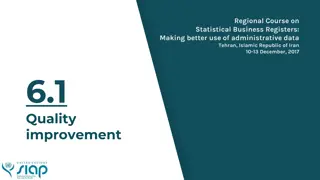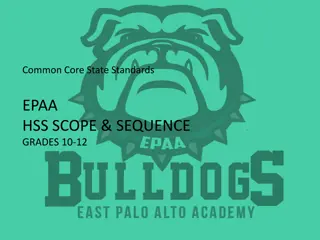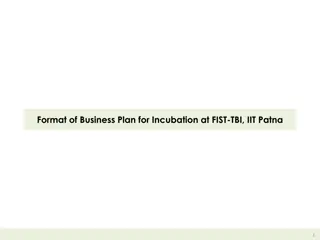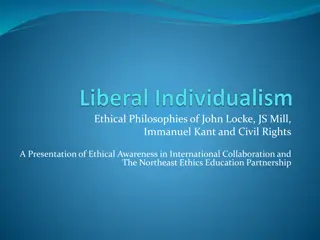Quality Management Philosophies and Dimensions at IIT Kanpur
MBA663:TQM at IIT Kanpur explores Total Quality Management (TQM), ISO 9000 standards, and Dimensions of Quality including performance, reliability, durability, serviceability, aesthetics, features, perceived quality, and conformance to standards. Quality is defined by fitness for use, design, and conformance, emphasizing customer requirements and reducing variability. Dr. Raghu Nandan Sengupta from the Department of Industrial and Management Engineering delves into the importance of quality in business success and competitiveness.
Download Presentation

Please find below an Image/Link to download the presentation.
The content on the website is provided AS IS for your information and personal use only. It may not be sold, licensed, or shared on other websites without obtaining consent from the author.If you encounter any issues during the download, it is possible that the publisher has removed the file from their server.
You are allowed to download the files provided on this website for personal or commercial use, subject to the condition that they are used lawfully. All files are the property of their respective owners.
The content on the website is provided AS IS for your information and personal use only. It may not be sold, licensed, or shared on other websites without obtaining consent from the author.
E N D
Presentation Transcript
TOTAL QUALITY MANAGEMENT AND QUALITY MANAGEMENT PHILOSOPHIES Dr. Raghu Nandan Sengupta Professor Department of Industrial and Management Engineering All figures are taken from(unless otherwise mentioned): Introduction to Statistical process Control Douglas. C Montgomery 6thEdition
2 MBA663:TQM R.N.Sengupta.IME Dept.,IIT Kanpur,INDIA Quality One of the most important decision factor in selection of products/services from competing sets Understanding and improving quality leads to business success, growth and competitiveness Can be defined as possession of one or more desirable characteristics for a product/service ISO 9000 Definition a degree to which a set of inherent characteristics that fulfils a need or expectation that is stated ,generally implied or is obligatory
3 MBA663:TQM R.N.Sengupta.IME Dept.,IIT Kanpur,INDIA Dimensions of Quality Performance Will the product do the intended job Reliability How often does the product fail Durability How long does the product last Serviceability How easy it is to repair the product
4 MBA663:TQM R.N.Sengupta.IME Dept.,IIT Kanpur,INDIA Dimensions of Quality Aesthetics What does the product look like Features what does the product do Perceived Quality What is the reputation of the company or its products Conformance to Standards Is the product made exactly as the designer intended
5 MBA663:TQM R.N.Sengupta.IME Dept.,IIT Kanpur,INDIA Definition of Quality Fitness for use Consists of two aspects Quality of design All automobiles have the same basic objective of providing transportation yet they are different in terms of size, shape, performance etc. Quality of Conformance How well the product conforms to the specification required by the design. Depends on choice of manufacturing process, training and supervision of workforce, types of process control, inspection activities etc.
6 MBA663:TQM R.N.Sengupta.IME Dept.,IIT Kanpur,INDIA Definition of Quality (continued) Above definition does not emphasize the focus on customer Quality is inversely proportional to variability If variability of an important characteristics of a product decreases, the quality of the product increases Variability here refers to unwanted variability Focusses on customer requirement of less variability
7 MBA663:TQM R.N.Sengupta.IME Dept.,IIT Kanpur,INDIA Meaning of Quality: A Final Perspective Consumer s and producer s perspectives depend on each other Consumer s perspective: PRICE Producer s perspective: COST Consumer s view must dominate
8 MBA663:TQM R.N.Sengupta.IME Dept.,IIT Kanpur,INDIA An example An automobile company in US received transmission parts from a domestic plant and from a Japanese Supplier Analysis of transmission cost for parts produced in US and Japan Huge difference in costs between the two sources To identify reasons for difference, the company selected Random Samples from plants, disassembled them and measured Critical to Quality characteristics
9 MBA663:TQM R.N.Sengupta.IME Dept.,IIT Kanpur,INDIA Understanding variability The units manufactured in US took up around 75% of the width of the specification while those manufactured in Japan took up around 25% Considerable less variability in Japanese products Customer does not see the mean, they look at the variability around the target that is not removed Jack Welch
10 MBA663:TQM R.N.Sengupta.IME Dept.,IIT Kanpur,INDIA Quality improvement Why and how did the Japanese do it? Why Reduced variability leads to lower costs (Fig 1.1) Japanese gears ran more smoothly with less noise and hence had a higher perceived quality in minds of the consumers Fewer repairs and warranty claims -> less rework -> reduction in wasted time effort money
11 MBA663:TQM R.N.Sengupta.IME Dept.,IIT Kanpur,INDIA Quality improvement How Quality improvement Reduction of variability in processes and products Reduction of waste Specially pertinent to the service industry improving service process leads to less effort and time in correction
12 MBA663:TQM R.N.Sengupta.IME Dept.,IIT Kanpur,INDIA Quality characteristics Quality characteristics Elements that describe what consumer perceives as quality Often referred to as Critical-To-Quality Characteristics Physical length, weight, voltage, viscosity Sensory taste, appearance, colour Time orientation reliability, durability, serviceability Quality engineering set of operational, managerial and engineering activities that the quality characteristics of a product are at a nominal or required levels and the variability around the desired levels is minimum
13 MBA663:TQM R.N.Sengupta.IME Dept.,IIT Kanpur,INDIA Quality characteristics No two products are ever identical variability The thickness of blades of a fan/between two fans will be different Customer may not accept product if this variability is large Sources of variability include difference in materials, difference in the performance and operation of the manufacturing unit etc. Specification Desired measurements of the characteristics A value of measurement that corresponds to the desired value for the quality characteristic is called the nominal or target value
14 MBA663:TQM R.N.Sengupta.IME Dept.,IIT Kanpur,INDIA Some Important Terminologies The largest allowable value for a quality characteristic is called the Upper Specification Limit (USL) The smallest allowable value for the quality characteristic is called the Lower Specification Limit (LSL) Nonconforming products which do not meet one or more of it s specifications A non-conforming product is called defective as it has one of or more defects A defect is the non-conformance to the specification
15 MBA663:TQM R.N.Sengupta.IME Dept.,IIT Kanpur,INDIA An Example Consider a blade of a fan Let length and thickness be two quality characteristics For length Target length:30 cm USL: 32 cm LSL:28 cm A blade having length between 28cm and 32cm is acceptable For thickness Target value: 10mm USL : 12 mm LSL: 8mm A blade having thickness between 8mm and 12 mm is acceptables
16 MBA663:TQM R.N.Sengupta.IME Dept.,IIT Kanpur,INDIA An Example (continued) If a blade has length 32cm and thickness 6 mm then it is said to be non-conforming/defective and has 1 defect (for the thickness) If a blade has length 33cm and thickness 9 mm then it is said to be non-conforming/defective and has 1 defect (for the length) If a blade has length 34cm and thickness 6 mm then it is said to be non-conforming/defective and has 2 defects (for the thickness) If a blade has length 32cm and thickness 8mm then it is said to be conforming and has no defect
17 MBA663:TQM R.N.Sengupta.IME Dept.,IIT Kanpur,INDIA Brief History of Quality Control and Improvement Year 1875 Event Frederick W. Taylor introduces Scientific Management principles to divide work into smaller, more easily accomplished units the first approach to dealing with more complex products and processes. The focus was on productivity. Later contributors were Frank Gilbreth and Henry Gantt. 1900 1930 Henry Ford the assembly line further refinement of work methods to improve productivity and quality; Ford developed mistake-proof assembly concepts, self- checking, and in-process inspection. 1907 1908 AT&T begins systematic inspection and testing of products and materials.
18 MBA663:TQM R.N.Sengupta.IME Dept.,IIT Kanpur,INDIA History of Quality Control Year 1908 Event W. S. Gosset (writing as Student ) introduces the t- distribution results from his work on quality control at Guinness Brewery. WWI British government begins a supplier certification program. AT&T Bell Laboratories forms a quality department emphasizing quality, inspection and test, and product reliability. B. P. Dudding at General Electric in England uses statistical methods to control the quality of electric lamps. W. A. Shewhart introduces the control chart concept in a Bell Laboratories technical memorandum. 1915 1919 1920s 1924
19 MBA663:TQM R.N.Sengupta.IME Dept.,IIT Kanpur,INDIA History of Quality Control Year 1928 Event Acceptance sampling methodology is developed and refined by H. F. Dodge and H. G. Romig at Bell Labs. W. A. Shewhart publishes Economic Control of Quality of Manufactured Product outlining statistical methods for use in production and control chart methods. The American Society for Quality Control (ASQC) is formed as the merger of various quality societies. The International Standards Organization (ISO) is founded. 1931 1946 Deming is invited to Japan by the Economic and Scientific Services Section of the U.S. War Department to help occupation forces in rebuilding Japanese industry. The Japanese Union of Scientists and Engineers (JUSE) is formed.
20 MBA663:TQM R.N.Sengupta.IME Dept.,IIT Kanpur,INDIA History of Quality Control Year Event 1948 G. Taguchi begins study and application of experimental design 1950 Deming begins education of Japanese industrial managers; statistical quality control methods begin to be widely taught in Japan. K. Ishikawa introduces the cause-and-effect diagram. ISO publishes the first quality systems standard. Motorola s six-sigma initiative begins. ISO 9000:2000 standard is issued. Supply-chain management and supplier quality become even more critical factors in business success. 1987 2000 Quality improvement activities expand beyond the traditional industrial setting into many other areas including financial services, health care, insurance, and utilities
21 MBA663:TQM R.N.Sengupta.IME Dept.,IIT Kanpur,INDIA Management Aspects of Quality Improvement Quality Planning A strategic activity without which enormous amount of time and effort may be wasted in dealing with faulty designs, manufacturing defects, customer complaints etc. It involves identifying the internal and external customers and listening to their needs (listening to the Voice of the Customer(VoC) Helps in developing products or services that exceed customer expectations
22 MBA663:TQM R.N.Sengupta.IME Dept.,IIT Kanpur,INDIA Management Aspects of Quality Improvement Quality Assurance - It is the set of activities that ensures the quality levels of products and services are properly maintained and that supplier and customer quality issues are properly resolved Documentation of quality system - policy, procedures, work instructions and specifications, and records. Policy -> what is to be done Procedure ->methods and personnel Work instruction and specification -> product/department oriented
23 MBA663:TQM R.N.Sengupta.IME Dept.,IIT Kanpur,INDIA Management Aspects of Quality Improvement Quality control and improvement The set of activities used to ensure that the products and services meet requirements and are improved on a continuous basis Since variability is a major source of poor quality, this involves uses of statistical techniques such as Statistical Process control and Design of Experiments Often done in a project by project basis
24 MBA663:TQM Quality Philosophy and Management Strategies - W. Edwards Deming 14 point frame work for quality and productivity improvement 1. Create a constancy of purpose focused on the improvement of products and services R.N.Sengupta.IME Dept.,IIT Kanpur,INDIA 2. Adopt a new philosophy that recognizes we are in a different economic era. 3. Do not rely on mass inspection to control quality 4. Do not award business to suppliers on the basis of price alone, but also consider quality 5. Focus on continuous improvement
25 MBA663:TQM R.N.Sengupta.IME Dept.,IIT Kanpur,INDIA Quality Philosophy and Management Strategies - W. Edwards Deming 6. Practice modern training methods and invest in on-the-job training for all employees. 7. Improve leadership, and practice modern supervision methods 8. Drive out fear 9. Break down the barriers between functional areas of the business. 10. Eliminate targets, slogans, and numerical goals for the workforce 11. Eliminate numerical quotas and work standards 12. Remove the barriers that discourage employees from doing their jobs. 13. Institute an ongoing program of education for all employees 14. Create a structure in top management that will vigorously advocate the first 13 points
26 MBA663:TQM R.N.Sengupta.IME Dept.,IIT Kanpur,INDIA Seven deadly sins of management: W. Edwards Deming Lack of constancy of purpose Emphasis on short-term profits Evaluation of performance, merit rating, and annual reviews of performance Mobility of top management Running a company on visible figures alone Excessive medical costs Excessive legal damage awards
27 MBA663:TQM R.N.Sengupta.IME Dept.,IIT Kanpur,INDIA Quality Philosophy and Management Strategies - W. Edwards Deming Recommended model for improvement Plan-Do-Check-Act, are often called the PDCA cycle. The check step is sometimes called Study The cycle becomes PDSA
28 MBA663:TQM Quality Management Philosphy: Joseph M Juran Three components Juran Trilogy of planning, control and improvement Planning Identifying external customers and their needs Planning for quality improvement on a regular basis Control Statistical Process control Improvement Project by project improvement Higher quality than current levels Breakthrough and incremental improvement R.N.Sengupta.IME Dept.,IIT Kanpur,INDIA
29 MBA663:TQM Quality Control: Armand V. Feigenbaum Introduced the concept of company wide quality control in the book Total Quality Control Three step approach to improving quality Quality Leadership Quality Technology Organizational Commitment 19 step quality improvement process R.N.Sengupta.IME Dept.,IIT Kanpur,INDIA
30 MBA663:TQM R.N.Sengupta.IME Dept.,IIT Kanpur,INDIA Total Quality Management A strategy for implementing and managing quality improvement strategies across the organization Started in 1980 with Deming s and Juran s philosophies Focus on all elements of organization on quality improvement efforts Major focus was on customer and integrating quality goals with business goals Different teams including quality council, cross-functional teams to improve quality Limited success
31 MBA663:TQM R.N.Sengupta.IME Dept.,IIT Kanpur,INDIA Total Quality Management A management philosophy and company practices that aim to harness the human and material resources of an organization in the most effective way to achieve the objectives of the organization." Formal definition of TQM as given by British Standards Institution Main targets of TQM Customer Satisfaction Continuous Operational Improvement Continuous Cost Reduction A want to culture instead of have to culture Highly Skilled Workforce
32 MBA663:TQM R.N.Sengupta.IME Dept.,IIT Kanpur,INDIA Quality Circle Organization 8-10 members Same area Supervisor/moderator Training Group processes Data collection Problem analysis Presentation Implementation Monitoring Problem Identification List alternatives Consensus Brainstorming Solution Problem results Problem Analysis Cause and effect Data collection and analysis
33 MBA663:TQM R.N.Sengupta.IME Dept.,IIT Kanpur,INDIA Reasons for Limited Success Ineffective training and lack of proper impact measurement Major focus was on customer and integrating quality goals with business goals Inadequate use of statistical methods and insufficient recognition of variability reduction as a prime objective General as opposed to specific business-results-oriented objectives Too much emphasis on widespread training as opposed to focused technical education Wrapping around ineffective programs like Zero Defects, Quality is free etc.
34 MBA663:TQM R.N.Sengupta.IME Dept.,IIT Kanpur,INDIA Basic Ideas of Probability distribution Consider the rolling of a dice Total there are 6 possible outcomes (1,2,3,4,5,6)(Sample Space) Say let X(random variable) denote the outcome 5 (when we toss a dice and a 5 appears) So probability(X=5)=1/6(No of favourable outcome/total possible outcomes) A probability distribution function can be thought of as a mathematical function which gives the probability for an outcome for a particular random variable
35 MBA663:TQM R.N.Sengupta.IME Dept.,IIT Kanpur,INDIA PMF and PDF Probability distribution functions can be for discrete and continuous events Discrete When the sample space is made of discrete events like tossing a dice will always have an outcome from the set(1,2,3,4,5,6) Continuous- When the sample space consists of continuous numbers like temperature of a room (it can be any continuous value between say 15 and 50 like 15.51 or 16.72) For the discrete case, the probability distribution is termed as Probability Mass Function(PMF) For the continuous case, the probability distribution is termed as Probability Density Function(PDF)
36 MBA663:TQM R.N.Sengupta.IME Dept.,IIT Kanpur,INDIA PMF- AN example (Rolling two dices) Probability Mass Function 0.18 0.16 0.14 0.12 Probability 0.10 0.08 0.06 0.04 0.02 0.00 2 3 4 5 6 7 8 9 10 11 12 Outcome
37 MBA663:TQM R.N.Sengupta.IME Dept.,IIT Kanpur,INDIA PDF Normal Distribution(Bell shaped curve) Normal Distribution 0.45 0.4 0.35 0.3 Probability 0.25 0.2 0.15 0.1 0.05 0 -6 -4 -2 0 2 4 6 Value of z The above graph shows the probability dictribution for a set of outcomes referred to as z values From the graph it can be said that probability of z=2 and z=-2 is equal and its value is .05 What if we want to find the probability for z>2 or z<3??
38 MBA663:TQM R.N.Sengupta.IME Dept.,IIT Kanpur,INDIA CDF PDF and PMF gives the probability at a point for continuous and discrete events What if we want to find the probability of a set of events as mentioned? Say from the normal graph, we want to find the probability of z<2 The probability will be equal to sum of all probability from -6(the leftmost point) to 2 The probability distribution which shows the sum of probability up to that point is termed as Cumulative Distribution Function(CDF)
39 MBA663:TQM R.N.Sengupta.IME Dept.,IIT Kanpur,INDIA CDF for Discrete case Probability Mass Function CDF 0.18 1.2 0.16 1 0.14 Probability 0.12 Cumulative Probability 0.8 0.10 0.6 0.08 0.4 0.06 0.04 0.2 0.02 0 2 3 4 5 6 7 8 9 10 11 12 0.00 Outcome 2 3 4 5 6 7 8 9 10 11 12 Outcome
40 MBA663:TQM R.N.Sengupta.IME Dept.,IIT Kanpur,INDIA CDF for Continuous Case Normal Distribution 0.45 0.4 0.35 0.3 Probability 0.25 0.2 0.15 0.1 0.05 0 -6 -4 -2 0 2 4 6 Value of z CDF 1.2 Cumulative Probability 1 0.8 0.6 0.4 0.2 0 -8 -6 -4 -2 0 2 4 6 8 -0.2 Z value
41 MBA663:TQM R.N.Sengupta.IME Dept.,IIT Kanpur,INDIA Standard Normal Distribution and Standard Normal Table(Cumulative) A normal distribution with mean= =0 and standard deviation= =1 is termed as a standard normal distribution
42 MBA663:TQM R.N.Sengupta.IME Dept.,IIT Kanpur,INDIA Six Sigma- An Overview Developed by Motorola around 1980s Focus is on reducing variability of product quality characteristics to a level at which defects becomes extremely unlikely We assume that a particular quality characteristic follow a normal distribution with mean= and standard deviation=
43 MBA663:TQM R.N.Sengupta.IME Dept.,IIT Kanpur,INDIA Sig Sigma(continued) The probability of producing a product within this specification is .9973 which transforms to around 2700 defective parts per million(ppm) (Three sigma quality performance) Consider a product which has 100 components of above type and for it to work correctly all 100 must function correctly So the probability that a particular product is non-defective from a basket of such products is given by: =.9973*.9973 .100times= (.9973)100 =.7631 So the probability that a product will be defective is around 23% Now consider the fact that for a car has around 100000 components and a an airplane has around 1 to2million components
44 MBA663:TQM R.N.Sengupta.IME Dept.,IIT Kanpur,INDIA Six sigma concept Reduce the variability in process so that the specification limits are at least 6 standard deviations( s) from the mean Under such a scenario the probability that the item is non defective is .9999998 or .2 ppm It is assumed that once six sigma level is reached, the process mean may shift by 1.5 s
45 MBA663:TQM R.N.Sengupta.IME Dept.,IIT Kanpur,INDIA Six Sigma An Overview Six sigma is used for improving corporate business performance by improving quality and lowering costs Individuals having special training on statistical methods and quality management/improvement tools are involved in implementing six sigma quality improvements Designated as Green Belt(least experienced), Black Belt(team leads) and Master Black Belt(technical experts who work with multiple teams and share their expertise)
46 MBA663:TQM R.N.Sengupta.IME Dept.,IIT Kanpur,INDIA DMAIC - 5 Step Problem Solving Approach
47 MBA663:TQM R.N.Sengupta.IME Dept.,IIT Kanpur,INDIA Structured Problem Solving DMAIC DMAIC is a structured problem soling methodology that can be used for cycle time reduction, throughput improvement etc. Each stage is followed by a tollgate Evaluation after completion of a particular stage to ensure project is on track and to allow suggestions for modification It uses a small set of powerful tools that can be specifically applied to each of the steps Cause and Effect->Measure Process capability analysis ->Measure Hypothesis Testing-> Analyze
48 MBA663:TQM R.N.Sengupta.IME Dept.,IIT Kanpur,INDIA Define Objective is to identify and validate a project opportunity Project must be important to customer as well as the business Project charter to be prepared
49 MBA663:TQM R.N.Sengupta.IME Dept.,IIT Kanpur,INDIA Define Graphical understanding of flow in a process-SIPOC Diagram Action plan for moving forward to other steps Tentative timeline, individual work assignments etc. Tollgate review Are stakeholders identified? Is the symptom appropriately being focussed?
50 MBA663:TQM R.N.Sengupta.IME Dept.,IIT Kanpur,INDIA Measure This step involves collection of data relating to quality, cost, throughput time etc. Develop a list of Key Process Input Variable(KPIV) and Key Process Output Variable(KPOV) Data collected tells us about the current state or baseline performance Important to measure the capability of measurement system using tools gauge repeatability and reproducibility Data collected can be displayed in forms of Pareto charts, histogram If needed project charter to be updated and team makeup to be revaluated Tollgate Review All assumptions made for data collection Complete process flow chart
